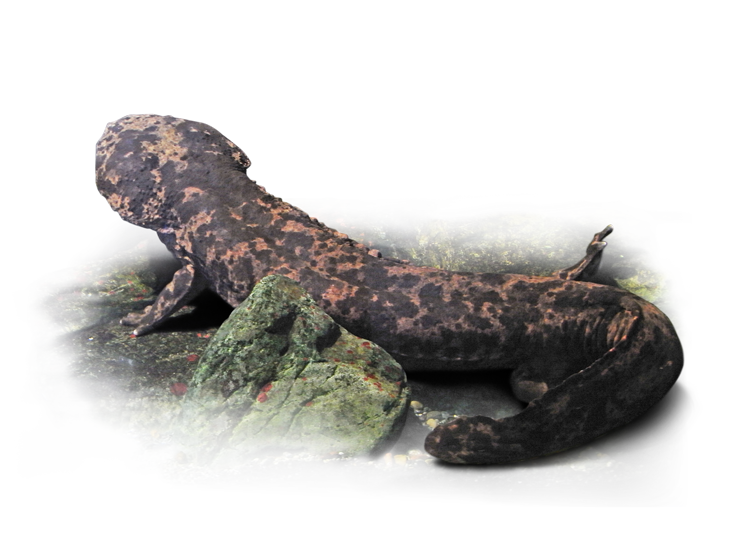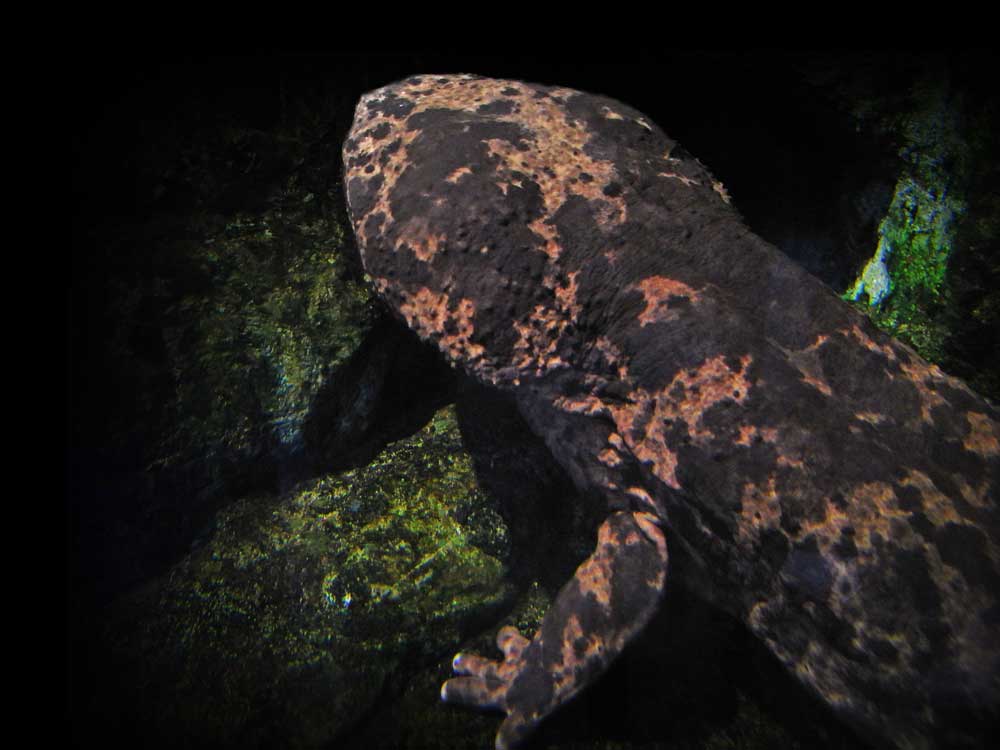
Andrias japonicus (Temminck, 1836)
洪水の証人
Witness of the Flood
世界最大級の両生類であり、平均体長は70〜80cm、最大で150cmにも達します。近縁種は中国原産のチュウゴクオオサンショウウオ (Andrias davidianus)、米国原産のヘルベンダー(Cryptobranchus alleganiensisなどがいますが、ヨーロッパでは約2300〜3000万年前の地層から、現在のオオサンショウウオの骨格とほとんど変わらない化石(Andrias scheuchzeri)が出土しており、かつてはユーラシア大陸全域に生息していたと考えられます。
ヨーロッパの化石が発見されたのは18世紀のことでドイツ南部の採石場でした。化石は聖書の洪水の科学的証拠を見つけたいという熱意ある化石蒐集家の医師の手に渡り、ノアの洪水で死んだヒトの化石と判断され「洪水の証人(Homo diluvii testis)」と名付けられました。後脚と尻尾が欠けており、堆積物によって押しつぶされた子供の骨格のように見えたのでしょう。19世紀になりフランスの動物学者ジョルジュ・キュヴィエが再検証し、これがオオサンショウウオの祖先にあたる化石であることを突き止めました。この化石伝説は後にカレル・チャペックの古典的SF傑作『山椒魚戦争』(1936)にも影響を与えたとされます。しゃべる能力を持つオオサンショウウオが人間と敵対して戦争に至る物語で、第二次世界大戦前夜の不安な空気を象徴的に描いています。
日本では「洪水とオオサンショウウオ」という組み合わせが現実に見られます。大雨で河川が増水した時に上流から流されてきたオオサンショウウオが下流の市街地などで見つかり、人々を驚かせニュースとなるのです。オオサンショウウオの別名「ハンザキ」は半分に裂かれても生きているという生命力の強さに由来し、古来より畏怖や信仰心を抱かせる存在です。
井伏鱒二の『山椒魚』は、成長しすぎて自分の棲家である岩屋から出られなくなってしまったサンショウウオの悲嘆を描いた作品です。1923年に『幽閉』として構想され、1929年に改題後もたびたび改稿されました。サンショウウオのその後は描かれていませんが、岩の中に幽閉されたまま、死を迎えるでしょう。そして何千万年もの時を経て岩と同化して化石となり…。歴史は廻ります。

“Homo diluvii testis” is species of Andrias scheuchzeri.

Johann Jakob Scheuchtzer, who claimed the fossils were those of humans who drowned in the flood.
The Japanese giant salamander is one of the largest amphibians in the world, averaging 70–80 cm in length and reaching up to 150 cm. Its close relatives include the Chinese giant salamander (Andrias davidianus) and the North American hellbender (Cryptobranchus alleganiensis). Fossils of a very similar species, Andrias scheuchzeri, have been unearthed from layers dating back 23–30 million years in Europe, suggesting that ancestors of the modern giant salamander once inhabited the entire Eurasian continent.
The European fossil was discovered in the 18th century in a quarry in southern Germany. It came into the hands of a physician and fossil collector eager to find scientific evidence of the Biblical flood. Believing it to be the remains of a human who perished in Noah’s flood, he named it Homo diluvii testis—“Witness of the Flood.” The specimen, lacking hind legs and a tail and flattened by sediment, indeed resembled the skeleton of a small child. In the 19th century, the French naturalist Georges Cuvier reexamined it and correctly identified it as a fossil of a giant salamander, an ancestor of the modern Andrias. This curious episode later inspired Karel Čapek’s classic science fiction novel War with the Newts (1936), in which intelligent salamanders rise up against humanity—an allegory of the anxious mood before World War II.
In Japan, the combination of “flood and salamander” can be witnessed in real life. During heavy rains, salamanders are often swept downstream and discovered in urban areas, startling residents and making the news. The creature’s Japanese name “Hanzaki” comes from the belief that even if cut in half, it can survive—a symbol of its vitality and a source of awe and reverence since ancient times.
Masuji Ibuse’s short story The Salamander portrays the sorrow of one that grows too large to leave its rocky dwelling. First conceived in 1923 under the title Imprisonment, it was revised several times after being renamed in 1929. The creature’s fate is left untold, yet one imagines it dying within its stone confinement—eventually fossilizing over millions of years. History, indeed, repeats itself.

参考文献
東京ズーネット | 動物たちの横顔 | 世界最大の両生類、オオサンショウウオ 2025年11月15日閲覧
琉球大学 | 研究成果 | 絶滅したオオサンショウウオが生きていた!―外来種が救う種の絶滅?― | (2024年2月8日) 2025年11月15日閲覧
安佐動物公園 | オオサンショウウオ 2025年11月15日閲覧
Graf, Felix (2024, July 18) “A witness to the Deluge” Swiss National Museum. 2025年11月15日閲覧